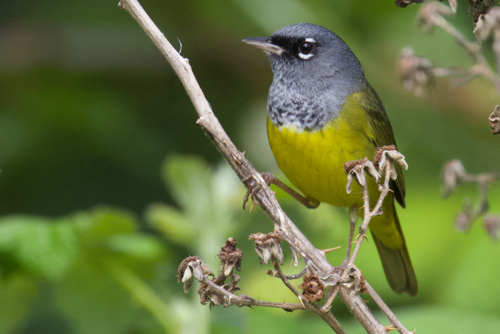
Macgillivray's Warbler
MacGillivray's Warbler (*Geothlypis tolmiei*) is a small, active songbird known for its skulking behavior and preference for dense undergrowth. It plays a vital role in its ecosystem as an insectivore, helping to control insect populations. While not particularly renowned in popular culture, it holds a place of interest among birdwatchers due to its distinctive, broken eye-ring and often-secretive nature. The species is named after Scottish ornithologist William MacGillivray.
11-13 cm
Length
15-19 cm
Wingspan
Least Concern
Conservation Status
Distribution
Western North America, from southeastern Alaska and British Columbia south to southern California, and east to the Rocky Mountains. Migratory, wintering in Mexico and Central America.
Lifespan
Up to 5-6 years in the wild, but typically shorter. Captive lifespan unknown.
Macgillivray's Warbler's Habitat
Habitat Types
Dense shrubby areas, Riparian thickets, Forest edges, Second-growth forests
Climate Zones
Temperate, Subtropical
Adaptations
Prefers dense understory vegetation, which provides cover for foraging and nesting. Their relatively long legs are adapted for hopping and maneuvering through dense tangles.
Variations
Two subspecies are generally recognized: *G. t. tolmiei* (western) and *G. t. monticola* (interior). Slight differences in plumage and size exist.
Appearance
Breeding Plumage
Males have a dark gray hood, while females and immatures have a paler gray or brownish-gray hood. Both sexes have olive-green upperparts and yellow underparts.
Seasonal Feather Changes
Minimal seasonal variation, but breeding males have the most intensely colored hood.
Sex Based Plumage Differences
Significant; males have a darker hood and more prominent broken white eye-ring than females.
Notable Features
Broken white eye-ring (prominent in males), Dark gray hood (in males), Olive-green upperparts, Yellow underparts
Diet and Feeding
Primary Foods
Insects, Spiders, Other small invertebrates
Foraging Behavior
Forages primarily on or near the ground, gleaning insects from leaves and branches in dense vegetation. Often flicks its tail and wings nervously while foraging.
Specializations
No highly specialized feeding adaptations, but its agility allows it to maneuver through dense undergrowth.
Seasonal Diet Variations
Diet may include some berries and small fruits in the fall and winter, but primarily insectivorous year-round.
Behavior
Social Structure
Generally solitary or in pairs during the breeding season. May form small flocks during migration and in winter.
Communication
Song is a series of clear, ringing notes, often described as 'chee-chee-chee-chory-chory', Call notes include a sharp 'chip' or 'check', Visual displays include wing-flicking and tail-flicking
Migration
Migrates at night. Travels from breeding grounds in western North America to wintering grounds in Mexico and Central America.
Territorial or Group Behaviors
Males defend territories during the breeding season through song and aggressive displays. Not known for strong group behaviors outside of migration.
Conservation
Threats
Habitat loss and degradation (due to logging, development, and agriculture), Pesticide use (which reduces insect prey), Climate change (potential shifts in suitable habitat)
Protection Programs
Monitoring programs (e.g., Breeding Bird Survey), Habitat conservation efforts in some areas
Local National Laws
Protected under the Migratory Bird Treaty Act in the United States and Canada.
Population Trend
Relatively stable, but some regional declines have been noted.
Population Estimates
Global population estimated at around 9 million individuals.
Interesting Facts
Often confused with Mourning Warblers.
MacGillivray's Warblers have a broken eye-ring, while Mourning Warblers have a complete eye-ring, or lack one altogether.
Skulking Behavior
They tend to stay hidden within dense vegetation, which making them hard to spot.
They are named after a Scottish ornithologist.
The species is named after William MacGillivray, a 19th-century Scottish naturalist.
Faqs about Macgillivray's Warbler
What is the best way to see a MacGillivray's Warbler?
Look for them in dense, shrubby habitats, especially during the breeding season. Listen for their distinctive song, and be patient – they can be difficult to spot.
Are MacGillivray's Warblers endangered?
No, they are currently listed as a species of Least Concern by the IUCN, but habitat loss is a potential threat.
Do MacGillivray's Warblers visit bird feeders?
Rarely. They are primarily insectivores and prefer to forage in dense vegetation.
Copyright @ Nature Style Limited. All Rights Reserved.
 English
English